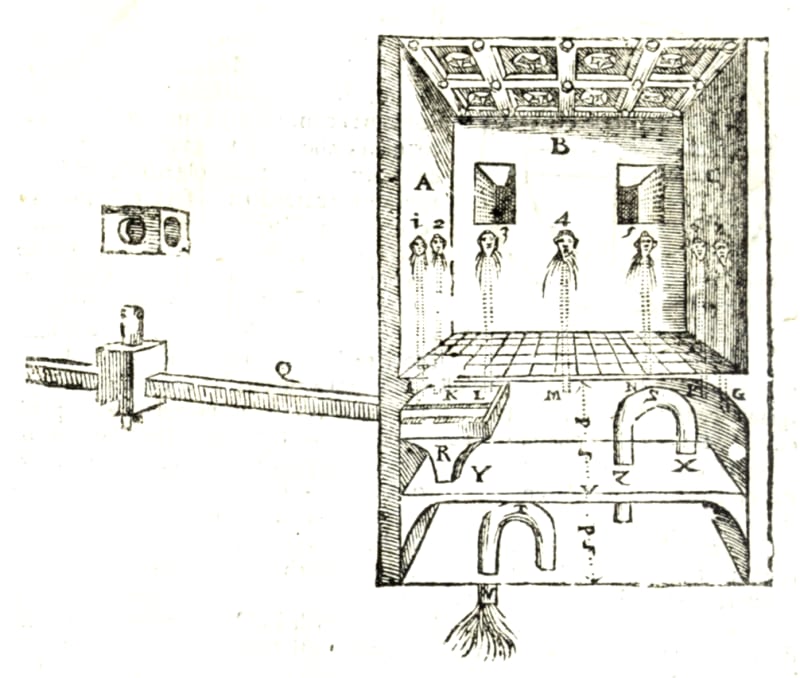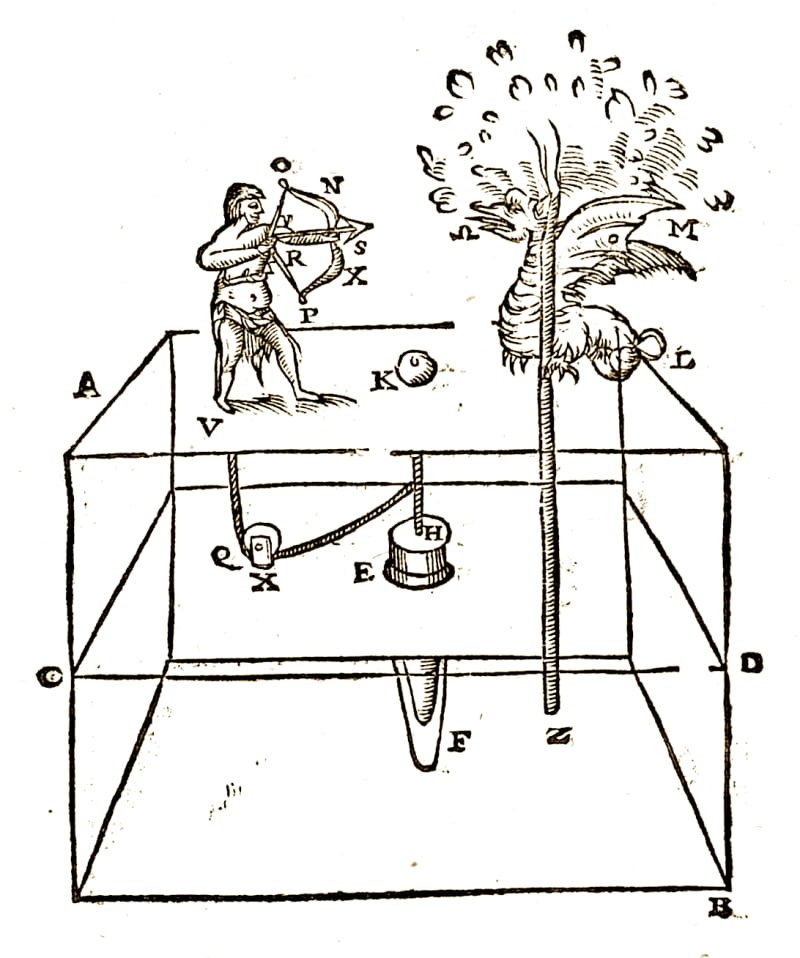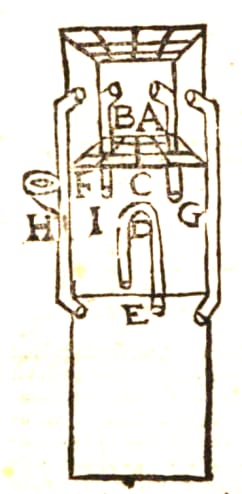Renaissance air conditioning

Hero of Alexandria, engineer and natural philosopher, lived in the first century AD and worked in that city’s celebrated Library and Museum. His best-known book is the Pneumatics, which might sound like a physics textbook, but is in fact a compendium of surprising devices, tricks and toys, some of which operate automatically once they are set going. Hero calls these ‘theorems’. His Theorem 40 has the caption: “On an apple being lifted, Hercules shoots a dragon which then hisses.”

The reference is to the eleventh labour of Hercules, when he was sent to steal apples from the Garden of the Hesperides, which were guarded by the hundred-headed dragon Ladon. The protagonists stand on two tanks, part-filled with water, one tank on top of the other. When the apple K *is lifted, this pulls a string that releases Hercules’s finger *R, and he fires his arrow. Simultaneously the plug H is removed, and water from the upper tank flows into the lower tank, raising the air pressure inside. Air is forced up the tube *Z *and blows a whistle in the dragon’s mouth.
Hero has other theorems comprised of similar stacks of tanks, with water moving from each tank to the one below, changing the air pressure or the water pressure. In one design, the principle is used to create a short-lived fountain of water. In other theorems, compressed air is forced up through pipes to the mouths of little birds who ‘sing’, just like the dragon.
The Pneumatics was seized on with great delight by Renaissance designers, who saw models for the automata they were planning to install in the grottoes of the great gardens of the late sixteenth century. Chief among these were the engineer/ architects Bernardo Buontalenti in Florence and Giovanni Battista Aleòtti in Ferrara. Both men made translations of Hero’s book into Italian. Aleòtti devoted much of his career to hydraulic engineering, and decided to introduce a small number of theorems of his own into his translation. These included pumps and Archimedean screws for raising water. Aleòtti added these in manuscript, with his own freehand drawings, into the back of a printed copy – now in the British Library - of his edition of 1589. Later this material was included, with the pictures engraved, in a second edition of 1647.
Aleòtti’s new Theorem 1 is captioned: “To create a room in which from time to time the wind blows and freshens the air – which will always be pleasant – either weakly or strongly, as desired.” The principle is illustrated in his diagram at the head of this article. Cool water from some source – perhaps a river or aqueduct – flows in through the pipe *Q *at the left. The flow can be controlled with a tap. There are two large chambers below the floor of the room, one on top of the other, as in the Hercules automaton. Rising water in the upper tank forces air up through small tubes in the walls of the room, which all end in human heads with open mouths that blow out the cool air. When the top tank is full of water it is drained to the lower tank by a type of U-shaped siphon. The lower tank is drained in its turn with a second siphon. Here is a sixteenth century air conditioner.

A system operating on these principles was installed below the ground floor of the Villa d’Este in Tivoli, in the 1560s. The idea may possibly have come from the architect and antiquarian Pirro Ligorio who advised Cardinal d’Este on the design of the gardens. Ligorio also worked as a hydraulics engineer, and he too had read Hero. The source of the water was the Aniene river, part of whose flow was diverted to supply the Villa’s spectacular fountains and cascades. The French philosopher and essayist Michel de Montaigne visited in 1581. He writes in his travel diary of “large hollows underneath the palace”, and “air holes which give out a cold vapour and impart a wonderful coolness to all the lower parts of the house.”

In 1601 the Neapolitan ‘professor of secrets’ Giovanni Battista della Porta published a book on pneumatics in three volumes, drawing heavily on Hero. Della Porta includes a crude diagram of the installation at the Villa d’Este and writes: “I will recount a way of how we can still create a strong wind – by making water fall through a channel into a chamber, and the longer the channel, the stronger the wind. In the same way, in the heat of the summer, we can cool rooms by circulating a strong and fresh wind. This we have seen in Tivoli.”
Hero, The Pneumatics of Hero of Alexandria, introduction by Marie Boas Hall, MacDonald, London and Elsevier, New York 1971: facsimile of edition byBennet Woodcroft, Taylor, Walton and Maberly, London 1851
Giovanni Battista Aleòtti, Gli Artificiosi et Curiosi Moti Spiritale di Herone, Carlo Zenero, Bologna 1647
Giovanni Battista della Porta, Pneumaticorum Libri Tres, Iacobum Carlinum, Naples 1601
David Dernie, The Villa d’Este at Tivoli, Academy Editions, London 1996